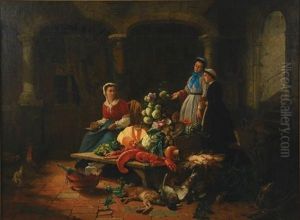Victor Emil Janssen Paintings
Victor Emil Janssen was a German artist, born in 1807 in Hamburg and passed away in 1845. His life spanned a period of significant transformation in Europe, marked by political upheaval, the Industrial Revolution, and the early stages of the Romantic movement in art and literature. Janssen's contributions to the art world, although not as widely recognized as some of his contemporaries, provide a fascinating glimpse into the stylistic transitions and cultural currents of his time.
Janssen's artistic journey began in his hometown of Hamburg, a city known for its vibrant cultural scene. From a young age, he showed a remarkable aptitude for drawing and painting, which led him to pursue formal education in the arts. He studied at the Hamburg Academy of Arts, where he was exposed to a range of artistic styles and techniques. His early work was influenced by the Neoclassical tradition, which was predominant at the time, characterized by its emphasis on clarity, order, and symmetry.
However, as Janssen's career progressed, his style evolved, showing a growing inclination towards Romanticism. This was a movement that sought to break away from the rigid conventions of Neoclassicism, focusing instead on emotion, nature, and the sublime. Janssen's later works are marked by a more dynamic use of color, light, and composition, reflecting his interest in capturing the transient effects of light and atmosphere, a hallmark of Romantic art.
Despite his talent and the quality of his work, Janssen struggled to gain widespread recognition during his lifetime. The art market in the early 19th century was highly competitive, and many talented artists found it difficult to achieve the acclaim and financial success of their more famous peers. Furthermore, Janssen's life was cut tragically short when he died in 1845 at the age of 38. The exact circumstances of his death remain unclear, but it is believed that he suffered from poor health throughout his life, which may have contributed to his early demise.
Today, Victor Emil Janssen is remembered as a skilled artist who contributed to the rich tapestry of 19th-century European art. His works, while not as prolific or widely known as some of his contemporaries, offer valuable insights into the artistic transitions of his time. They are cherished by art historians and collectors who appreciate the depth and sensitivity of his approach to painting. Janssen's legacy, though modest, underscores the importance of recognizing and celebrating the contributions of artists who may not have achieved widespread fame but whose work enriches our understanding of the past.



